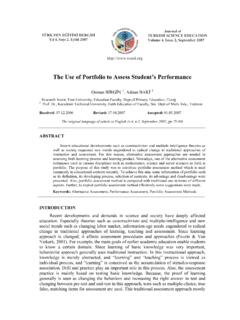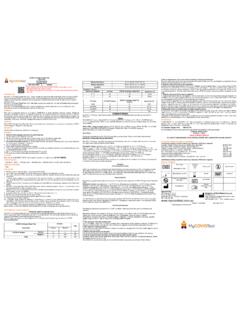Transcription of L2 learners' Anxiety, Self-Confidence and Oral performance
1 L2 Learners' Anxiety, Self-Confidence and oral performance Hyesook Park & Adam R. Lee Kunsan National University, Concordia University Abstract This study examined the relationships between L2 learners' anxiety, Self-Confidence and oral performance . The participants were 132 Korean college students who enrolled the English conversation classes in 2004. Questionnaires related to anxiety and Self-Confidence were given to the students and their oral performances were assessed in terms of IATEFL's criteria. Factor analysis indicated that communication anxiety, criticism anxiety, examination anxiety were the main components of anxiety, while situational confidence, communication confidence, language potential confidence and language ability confidence were the components of Self-Confidence for Korean learners of English. The results of the analyses showed that there were significant effects of anxiety and Self-Confidence on L2 learners' oral performance : The higher anxious the students were about speaking English, the lower scores they gained on their oral performance ; The higher confident they were, the higher oral performance they showed.
2 The correlation analysis of anxiety/confidence and the elements of oral performance showed that confidence was more closely correlated with the L2 learner' attitude and interaction including communication strategies and social conversation skills of oral performance , while anxiety was more negatively correlated with the L2 learner's range of oral performance such as vocabulary and grammar. 1. Introduction More and more attention has been drawn to the individual variations in language learning since 1970s. Individual variations can be attributed to cognitive and affective sides of language learning. Accordingly, both cognitive and affective sides of language learning may be considered in order to achieve successful language learning and teaching, However, actually, until now, research and attention have been concentrated on cognitive aspects of the learner. Affect in language learning involves various aspects of emotion, feeling, attitude of the learner.
3 Affective sides of language learners may influence the learners' language learning processes, positively or negatively. Thus, a right understanding of affect in foreign language learning can lead to more effective language learning and teaching. Anxiety is one of the most negatively influential affective variables, which prevents learners from successfully learning a foreign language. It makes language learners nervous and afraid, which may contribute to poor aural/ oral performance . One of the personal factors, which are highly correlated with anxiety, is Self-Confidence . Self-Confidence involves judgments and evaluations about one's own value and worth. Self-Confidence can be negatively influenced when the language learner thinks of oneself as deficient and limited in the target language. On the other hand, Joint authors: Hyesook Park, Adam R. Lee. 197high Self-Confidence can be positively correlated with oral performance (Heyde, 1979).
4 Further, highly anxious learners might deal with their target language task differently from one another, depending on their Self-Confidence . With the advent of communicative language teaching, English education in Korea has been changed to focusing on improving communicative ability. As a result, Korean learners of English are struggling to improve and develop their English communicative skills, in particular, listening and speaking skills. Meanwhile, affect in language learning and teaching has been emerged and considered as an important side with the cognitive side of language learning. Among affective variables, anxiety and Self-Confidence are representative barriers Korean learners of English are facing in communicative language classroom. Thus, this study takes an aim to investigate the relationships of anxiety, Self-Confidence and Korean learners' oral performance in English. First, the components of anxiety and Self-Confidence will be explored through factor analysis.
5 Then, the correlations between anxiety/ Self-Confidence and oral performance will be examined and then the relationships among anxiety, Self-Confidence and oral performance will be analyzed by ANOVA. 2. Literature Review Every human being possesses some extent of Self-Confidence , self-esteem, and belief in one's own abilities in carrying on one's own task, although the extent is different from each other1. Men grow with the development of a concept of self from experiences with themselves and others and the external world around him. And a sense of self-esteem may be derived from assessing the self in relation to others and the external world. According to Coopersmith (1967), "self-esteem is a personal judgment of worthiness that is expressed in the attitudes that individuals hold towards themselves. It is a subjective experience which the individual conveys to others by verbal reports and other overt expressive behavior.
6 "( ). Three levels of self-esteem have been mentioned in the literature: Global, situational, task self-esteem (Brown, 2000, ). Global self-esteem is the general assessment one makes of one's own worth or value over time and across different situations. Thus, it is, in a sense, an overall self-appraisal. Situational self-esteem involves one's self-appraisal in specific traits such as intelligence and athletic ability, or particular situations such as education, work, and home. Task self-esteem refers to one's own assessment in particular tasks of particular situations. For example, within second language acquisition domain, task self-esteem might relate to particular language skills such as listening, speaking, reading and writing. Research on self-esteem and second language acquisition has shown that it is an important affective variable in successful second language acquisition. Heyde (1979) examined the effects of self-esteem on oral performance by American college students learning French as a foreign language.
7 1 In this study, Self-Confidence and self-esteem are interchangeably used. 198 She showed that self-esteem correlated positively with the students' scores in oral performance measures. MacIntyre, Dornyei, Clement, and Noels (1998) suggested that Self-Confidence significantly contributes to the learner's willingness to communicate in a foreign language. According to them, affective factors such as motivation, personality, intergroup climate, and self-esteem underlie willingness to communicate, and the factor of self-esteem including overall self-esteem in L2 and situational Self-Confidence in communication play an important role in determining the learner's willingness to communicate. Anxiety is a complex affective concept associated with feelings of uneasiness, frustration, self-doubt, apprehension, or worry (Scovel 1978, p. 134). Recent research on anxiety and language learning distinguishes foreign language anxiety from trait anxiety, which is one s general and global disposition, focusing on specifically on the situational nature of language learning.
8 Horwitz, Horwitz, and Cope (1986) defined foreign language anxiety as "a distinct complex of self-perception, beliefs, feelings, and behaviors related to classroom language learning arising from the uniqueness of the language learning process" ( cited in Aida, 1994). Three components of foreign language anxiety has been identified and examined: communication apprehension, test anxiety, and fear of negative evaluation. L2 communication apprehension is a person's level of fear or anxiety associated with either real or anticipated communication with another person or persons. Test anxiety is apprehension over academic evaluation. Test anxiety may be generated by deficits in students' learning and study skills. Or it can be caused by students' poor performances in the past. The third component, fear of negative social evaluation, is defined as apprehension about others' evaluation from a learner's need to make a positive social impression on others.
9 Studies on anxiety have reported different effects of anxiety on second or foreign language learning and performance (Aida, 1994; Chastain, 1975; MacIntyre & Gardner, 1989; Philips, 1992). Aida (1994) examined the relationships of foreign language anxiety and students' performance in Japanese learning for native English speakers. She used Horwitz et al.'s construct of foreign language anxiety as a research framework and partially supported the validity of Horwitz et al.'s Foreign Language Classroom Anxiety Scale (FLCAS). However, test anxiety, which was Horwitz et al.'s component of foreign language anxiety, was not supported. Based on these findings, she suggested that test anxiety might not be specifically germane to foreign language anxiety. Philips (1992) showed that there is a relationship between language anxiety and oral performance , reporting that the more anxious the students were, the lower performance they displayed in oral tests.
10 Besides, the anxious students expressed their negative attitudes toward oral tests. The results of the study suggest that language anxiety can make an effect on the learner' performance and his or her attitudes toward language learning. Chastain (1975) examined the correlation between ability and affective factors including test anxiety and foreign language learners' course grades. In the study, the results in the correlations of test anxiety and final grades were not consistent across languages. While test anxiety was a 199significant predictor for Spanish, it was negatively correlated with French audio-lingual class. For these results, he suggested that some anxiety about test might be helpful for language learning, while too much concern about test may bring about harm in language learning. This implies that anxiety cannot be regarded simply as a negative factor for successful language learning and that to some extent anxiety may lead to better language learning outcomes, making the learner have a optimal tension for good language learning.



![The Ontario Curriculum, Grades 1-8, Language [revised] 2006](/cache/preview/d/5/3/5/d/c/7/4/thumb-d535dc7439a04910d8a17bf7f1d6b83f.jpg)

